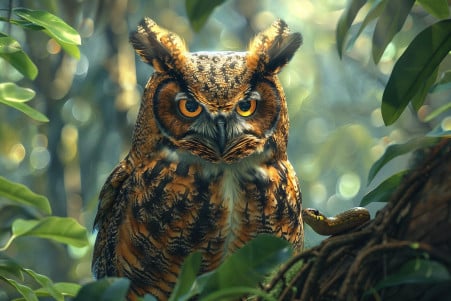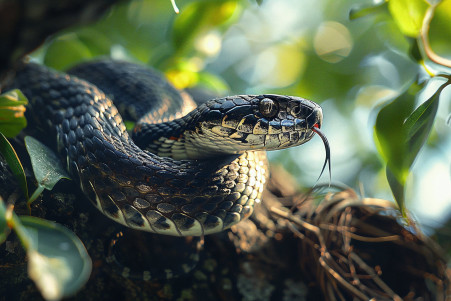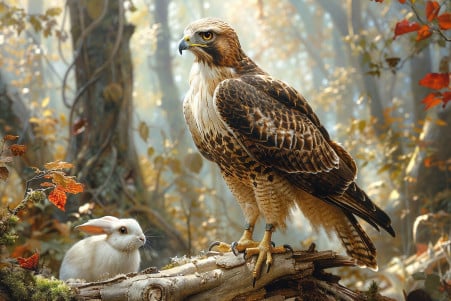Do Hawks Eat Snakes? A Look into Their Predatory Diet
28 February 2024 • Updated 29 February 2024

Hawks are beautiful birds that are known for their ability to fly high in the sky, but do they have a taste for serpents? The answer is yes, hawks eat snakes, and it’s just one part of their diverse diet. Hawks have evolved special hunting skills that allow them to catch and eat both venomous and non-venomous snakes, and this helps keep snake populations in check while also maintaining balance in the environment.
This article will look at a number of different bird and ecological studies that have helped to shed light on what hawks eat, and specifically how they interact with snakes as a food source. This will include everything from what’s been learned from watching hawks in the field to studies of prey–predator relationships.
As well as the anatomical and behavioral traits that have made it possible for hawks to eat the things they do. Let’s take a closer look at the complex web of life that connects hawks, snakes, and the world around them.
Do hawks eat snakes?
Hawks’ Hunting of Snakes: A Strategic Overview
Feathers versus scales—a battle choreographed in the wild. Multiple species of hawks, including the Red-Tailed Hawk, Harris Hawk, Cooper’s Hawk, and the Crested Serpent Eagle, have become highly skilled at hunting and eating snakes. According to MyBirdFeed, birds of prey have developed highly specialized hunting techniques to effectively catch their slithery prey, and as a result, snakes, including venomous snakes such as cobras and copperheads, have become a major part of their diet.
Using a variety of hunting techniques, hawks use their incredible eyesight and fast-flying skills to surprise their prey. As described by Nature Mentor, these techniques include everything from high soaring to perch-and-swoop, and each is highly specialized to the hawks’ environment and the type of prey they are hunting.
Once the hawks have caught their prey, they are known to immobilize them by pinning them down or grabbing them behind the head to prevent them from fighting back, and then they deliver a killing bite with their sharp beaks.
Hawks have also evolved physiological defenses against snake venom, which is a perfect example of the evolutionary arms race between predators and their prey. This, combined with their strategic hunting techniques, ensures that snakes will continue to be a part of their diet.
Hawks’ adaptability to a wide range of environments, including urban ones, and their relationship with snakes, shows that their role in the ecosystem is constantly changing, as noted by A-Z Animals. This predator-prey relationship has a huge impact on the behavior and survival of both species.
The Balance of Predation: Hawks and Snake Populations
As apex predators, hawks are well-known for their important role in maintaining the balance of ecosystems. Their predation on snakes is a perfect example of the balance of nature.
According to the Nature Blog Network, birds, including hawks, that feed on snakes are important in keeping the populations of snakes in check. This not only helps to control the number of snakes but also affects their behavior and distribution, helping to maintain a balance in the environment.
Endangered Species International points out that birds like hawks are found at multiple trophic levels in the food web, and their predation has a direct effect on the populations of the animals they eat.
As a result, changes in the population of hawks can have a disproportionate effect on the population of snakes, which could have a negative impact on the balance of the environment.
The Citizen Potawatomi Nation’s Public Information Office explains that raptors have been identified as indicator species because changes in their populations can indicate the health of an environment.
Knowing how hawks’ predation affects snakes helps us understand the fragile nature of our ecosystems and sets the stage for a deeper look at the physical and behavioral characteristics of hawks that help them be successful snake predators.
Hawks’ Skill at Hunting Snakes
Hawks are known for their unique physical adaptations that make them particularly skilled at hunting snakes. According to AvianStory, these adaptations include powerful talons and a sharp, curved beak that have evolved to help hawks catch and kill snakes, even venomous ones. In addition, hawks have excellent eyesight that helps them spot well-camouflaged or fast-moving prey, which they can use to zero in on their target and swoop in for the kill.
In terms of hunting behavior, hawks use a range of tactics to catch snakes. According to Reptile Knowledge, hawks often use stealth and surprise attacks from perched or aerial positions. In addition, when hunting venomous snakes, hawks use a matador-like technique that allows them to avoid being bitten by quickly and carefully subduing the snake.
Although hawks are not immune to snake venom, their hunting methods often prevent them from being bitten. According to research published in PMC by Bryan G. Fry, some birds of prey, including hawks, have been found to have resistance to certain snake venom neurotoxins, although this resistance is not common among birds that eat snakes.
The ongoing evolutionary battle between hawks and the snakes they eat continues to influence their hunting skills, ensuring that hawks will remain effective snake hunters in their natural habitats.
The Ripple Effect of Raptors: Snake Behavior and Evolution under Hawk Predation
The influence of hawk predation on snakes is far-reaching, impacting everything from snake behavior to population dynamics. For example, a study in Frontiers in Zoology showed that snakes like the Vipera graeca adjust their daily routines to avoid the peak hunting times of raptors, a direct response to the threat of raptor predation.
These changes in behavior are made with purpose—snakes increase their activity levels during the early morning and late afternoon, times when they are less likely to come into contact with their avian predators. However, this behavioral change comes at a cost to the snakes, as it may limit their ability to forage and thermoregulate.
In addition to impacting snakes at the individual level, the pressure of hawk predation may also lead to evolutionary changes in snake populations. A study in Scientific Reports showed that snakes that make morphological or behavioral changes in response to predation may increase their likelihood of survival, while those that don’t may face extinction.
In this predator-prey relationship, the influence of hawks on snakes is profound, with every move and countermove made by the two species potentially impacting the long-term survival of these serpents.
Taking this one step further and considering the important role that hawks play in ecosystems, it becomes clear that the impact of their predation on snakes goes beyond the immediate survival of individual snakes and may even help shape the larger ecological story through evolutionary forces.
Forever in the Skies: The Conservation of Hawks
Hawks’ predatory nature, which includes eating snakes, is an important part of the ecosystem. Yet, according to The Peregrine Fund, these birds of prey are facing a number of threats in the wild, including loss of their natural habitats, electrocution by power lines, and death from collisions with wind turbines.
Meanwhile, the Red-tailed Hawk, which is one of the most common hawks in North America, is also at risk from illegal hunting and capture, which can lead to a decline in their population.
Conservation efforts are therefore necessary to ensure the survival of hawks and the ecosystems that depend on them. By conducting studies, preserving natural habitats, and educating the public, organizations like The Peregrine Fund are working to protect raptors. They also maintain reserves like the Morley Nelson Snake River Birds of Prey Conservation Area, which provide safe spaces for hawks to live and continue to act as apex predators.
In summary, it’s important to recognize the impact of human activities and conservation measures on the predatory role of hawks. After all, the conservation status of these birds not only impacts their role in the ecosystem but also the health and balance of the habitats they survey from their place at the top of the food chain.
Striking a Balance: Hawks and the Snake Spectrum
In the complex web of life, hawks are important predators of snakes and help keep the balance in a variety of ecosystems. Our evidence demonstrates that hawks eat snakes, including venomous species, and this emphasizes their role in controlling snake populations. By selectively preying on snakes, these birds of prey influence the behavior and evolution of their prey, contributing to the constantly changing stability of nature.
Understanding the predator-prey relationship between hawks and snakes is important for the management of ecosystems. By looking at this relationship, we can learn more about the ecological roles of these animals and gain a greater understanding of their place in the world.
As we wrap up this article, we want to highlight the importance of the ongoing research and conservation work that focuses on hawks. Not only does learning more about what these birds eat and how they live enrich our understanding of the world, it also helps us protect biodiversity.
May we continue to respect these avian sentinels and keep their skies clear so they can continue to fulfill their important place in the circle of life.


